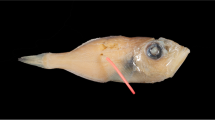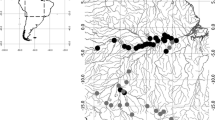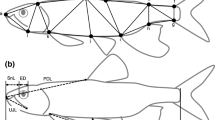Abstract
Larvae of several ocean pelagic fish species, such as tunas and marlins, have been known to have large jaws, but the ecological significance of this unique morphological character has been hardly analyzed in evolutionary ecology. Pelagic spawners produce small and nutrition-poor ova, and spawning and nursery grounds of the open ocean migratory fishes are oligotrophic. We hypothesize that cannibalism would be a possible life style in the larval period and the large mouth gape would be an adaptive morphological characteristic for a cannibal in the oligotrophic pelagic environment. We showed that mouth gape size of the open ocean pelagic fish is significantly larger than that of offshore/coastal pelagic fish in larval period. A mathematical model demonstrated that cannibalism would tend to evolve in high sea environment. Our findings suggest an evolutionary pattern of cannibalism trait in the larval stage of pelagic fishes.
Similar content being viewed by others
References
Block, B.A., Finnerty, J.R., Stewart, A.F.R. and Kidd, J. (1993) Evolution of endothermy in fish: mapping physiological traits on a molecular phylogeny. Science 260, 210–214.
Bogstad, B., Lilly, G., Mehl, S., Pálsson, Ó.K. and Stefánsson, G. (1994) Cannibalism and year-class strength in Atlantic cod (Gadus morhua L.) in the Arcot-boreal ecosystems (Barents Sea, Iceland and Eastern Newfoundland). ICES Marine Sci. Sympo. 198, 576–599.
Bry, C., Basset, E., Rognon, X. and Bonamy, F. (1992) Analysis of sibling cannibalism among pike, Esox lucius, juveniles reared under semi-natural conditions. Envi. Biol. Fish. 35, 75–84.
Crump, M.L. (1992) Cannibalism in amphibians. In: M.A. Elgar and B.J. Crespi (eds) Cannibalism: Ecology and Evolution among Diverse Taxa. Oxford University Press, Oxford, pp. 256–276.
DeAngelis, D.L., Cox, D.K. and Coutant, C.C. (1979) Cannibalism and size dispersal in young-of-the-year largemouth bass: experiment and model. Ecol. Model. 8, 133–148.
Dominey, W.J. and Blumer, L.S. (1984) Cannibalism of early life stages in fishes. In G. Hausfater and S.B. Hrdy (eds) Infanticide, Comparative and Evolutionary Perspective. Aldine, New York, pp. 43–64.
Dong, Q. and Polis, G.A. (1992) The dynamics of cannibalistic populations: a foraging perspective. In: M.A. Elger and B.J. Trespi (eds) Cannibalism. Oxford University Press, Oxford, pp. 13–37.
Elger, M.A. and Crespi, B.J. (1992) Ecology and evolution of cannibalism. In M.A. Elger and B.J. Crespi (eds) Cannibalism. Oxford University Press, Oxford, pp. 1–12.
Folkvord, A. (1991) Growth, survival and cannibalism of cod juveniles (Gadus morhua L.): effects of feed type, starvation and fish size. Aquaclture 97, 41–59.
Folkvord, A. (1997) Ontogeny of cannibalism in larval and juvenile fishes with special emphasis on Atlantic cod. In R.C. Chambers and E.A. Trippel (eds) Early Life History and Recruitment in Fish Populations. Chapman & Hall, London, pp. 251–278.
Folkvord, A. and Otterå, H. (1993) Effects on initial size distribution, day length and feeding frequency on growth, survival and cannibalism in juvenile Atlantic cod (Gadus morhua L.) Aquaculture 114, 243–260.
Folkvord, A., Øiestad, V. and Kvenseth, P.G. (1994) Growth patterns of three cohorts of Atlantic cod larvae (Gadus morhua L.) studied in a macrocosm. ICES Journal of Marine Sci. 51, 325–336.
Fortier, L. and Villeneuve, A. (1995) Cannibalism and predation on fish larvae by larvae of Atlantic mackerel, Scomber scombrus: trophodynamics and potential impact on recruitment. Fish. Bull. 92, 268–280.
Fox, L.R. (1975) Cannibalism in natural populations. Ann. Rev. Ecol. Syst. 6, 87–106.
Hecht, T. and Pienaar, A.G. (1993) A review of cannibalism and its implications in fish larviculture. Journal of the World Aquacul. Soci. 241, 246–261.
Hunter, J.R. and Kimbrell, C.A. (1980) Early life history of Pacific mackerel, Scomber japonicus. Fish. Bull., US. 78, 89–101.
Johnson, J.M. and Post, D.M. (1996) Morphological constraints on intracohort cannibalism in age-0 Largemouth bass. Trans. Am. fish. Soci. 125, 809–812.
Katavic, I., Jug-Dujakovic, J. and Glamuzina, B. (1989) Cannibalism as a factor affecting the survival of intensively cultured sea bass (Dicentrarchus labrox) fingerlings. Aquaculture 77, 135–143.
Kisdi, E. and Meszena, G. (1993) Density dependent life history evolution in fluctuating environments. In J. Yoshimura and C.W. Clark (eds) Adaptation in Stochastic Environments Springer-Verlag, Berlin, pp. 26–62.
Koeller, P.A., Coates-Markle, L. and Neilson, J.D. (1989) Feeding ecology of juvenile (age-0) silver hake (Merluccius bilinearis) on the Scotian Shelf. Cana. J. Fish. Aqua. Sci. 46, 1762–1768.
Li, S. and Mathias, J.A. (1982) Causes of high mortality among cultured larval walleyes. Trans. Am. Fish. Soci. 111, 710–721.
Miller, T.J., Crowder, L.B., Rice, J.A. and Marschall, E.A. (1988) Larval size and recruitment mechanisms in fishes: toward a conseptual framework. Cana. J. Fish. Aqua. Sci. 45, 1657–1670.
Nakamura, I. and Parin, N.V. (1993) FAO species catalogue. Vol 15. Snake mackerels and cutlassfishes of the world (Families Gempylidae and Trichiuridae). FAO Fish. Synop. 15, 1–136.
Nelson, J.S. (1984) Fishes of the world, 2nd edn. John Wiley & Sons, New York.
Ochiai, A. and Tanaka, M. (1986) Ichtyhology II. Kouseisya, Tokyo, Japan.
Okiyama, M. and Ueyanagi, S. (1977) Larvae and juvenile of the Indo-Pacific dogtooth tuna, (Rüpell). Bull. Far Seas Fish. Res. Lab. Jpn. 15, 35–49.
Okiyama, M. (1988) An atlas of the early stage fishes in Japan. Tokai University Press, Tokyo.
Otterå, H. and Folkvord, A. (1993) Allometric growth in juvenile cod (Gadus morhua L.) and possible effects on cannibalism. J. Fish Biol. 43, 643–645.
Parazo, M.M., Avila, E.M. and Reyes, D.M.J. (1991) Size-and weight dependent cannibalism in hatchery-bred sea bass (Lates calcarifer Bloch). J. Appl. Ichthyol. 7, 1–7.
Parrish, R.H., Nelson, C.S. and Bakun, A. (1981) Transport mechanisms and reproductive success of fishes in the California current. Biol. Oceanog. 1, 175–203.
Pepin, P. (1991) Effect of temperature and size on development, mortality, and survival rates of the pelagic early life history stages of marine fish. Cana. J. Fish. Aqua. Sci. 48, 503–518.
Perry, R.I. and Neilson, J.D. (1988) Vertical distributions and trophic interactions of age-0 Atlantic cod and haddock in mixed and stratified waters of Georges Bank. Marine Ecol. Prog. Seri. 49, 199–214.
Polis, G.A. (1981) The evolution and dynamics of intraspecific predation. Ann. Rev. Ecol. Syst. 12, 225–251.
Post, J.R. (1990) Metabolic allometry of larval and juvenile yellow parch (Perca flavescens): in situ estimates and bioenergetic models. Cana. J. Fish. Aqua. Sci. 47, 554–560.
Ridley, M. (1996) Evolution, 2nd edn. Blackwell, Cambridge.
Shirota, A. (1970) Studies on the mouth size of fish larvae. Bull. the Japanese Soci. Sci Fish 36, 353–368.
Shirota, A. (1978) Studies on the mouth size of fish larvae-II: specific characteristics of the upper jaw length. Bull. the Japanese Soci. Sci Fish. 44, 1171–1177.
Smith, C. and Reay, P. (1991) Cannibalism in teleost fish. Rev. Fish Biol. Fish. 1, 44–64.
Sogard, S. and Olla, B.L. (1994) The potential for intracohort cannibalism in age-0 walleye pollock, Theragra chalcogramma as determined under laboratory conditions. Env. Biol. Fish. 39, 183–190.
Stenseth, N.C. and Reed, J. (1978) A comment on Bobisud's paper on evolution of cannibalism. Bull. Math. Biol. 40, 541–545.
Stephens, D.W. and Krebs, J.R. (1986) Foraging theory. Princeton University Press, New Jersey.
Werner, E.E. and Gilliam, J.F. (1984) The ontogenic niche and species interactions in size-structured populations. Ann. Rev. Ecol. Syst. 15, 393–425.
Young, J.W. and Davis, T.L.O. (1990) Feeding ecology of larvae of southern bluefin, albacore and skipjack tunas (Pisces: Scombridae) in the eastern Indian ocean. Marine Ecol. Prog. Seri. 61, 18–29.
Author information
Authors and Affiliations
Rights and permissions
About this article
Cite this article
Nishimura, K., Hoshino, N. Evolution of cannibalism in the larval stage of pelagic fish. Evolutionary Ecology 13, 191–209 (1999). https://doi.org/10.1023/A:1006624331190
Issue Date:
DOI: https://doi.org/10.1023/A:1006624331190




